Stages of building a canopy
Preparation works. First of all, they prepare a place for the location of the canopy. It is cleared of plantings, debris, markings are made. The prepared site is leveled by pouring soil, sand, small pebbles or crushed stone into the recesses, or the existing hills are cut off. Then everything is thoroughly tamped.
In the case of adding a canopy to a residential building, you need to drill or dig pits to a depth of 50-60 centimeters, with a diameter of about 20 centimeters. They are necessary for the construction of the base for the canopy. At the same time, a cable for conducting lighting should be laid. Depending on the size of the canopy being built and the materials used for its construction, the pillars are placed at a distance of 1-1.5 meters from each other. The convenience of such a base for a canopy is that there is no need to dock to the main foundation of the house.
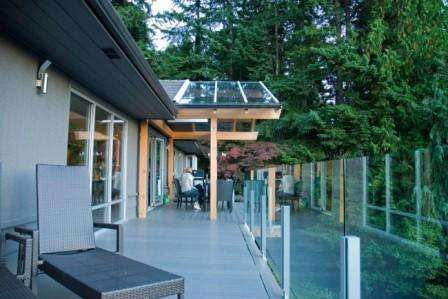
In all the grooves, you need to pour crushed stone over a bucket, install vertical posts and fill with cement mortar. Each support is leveled. If the canopy is made of wood, then the lumber must be dried and sanded. Before installing the board, it is necessary to impregnate with an antiseptic, proliferate or paint. If the canopy is located in the lowlands, then the ends of the wooden posts need waterproofing. To do this, they are wrapped with roofing material or film and hot bitumen is used to fill them. When planning the installation of metal supports, it is recommended to take an aluminum or galvanized profile. If ordinary metal is used, then it should be treated with a primer containing zinc phosphate in its composition.
Covering as a floor under a canopy can be:
- poured, from concrete or cement mortar;
- tiled paving or wooden;
- from medium-sized gravel or sand.
Installation works on the construction of a fiberglass canopy. The assembly of the extension begins after the concrete under the supports has completely solidified (about 14 days). To the wall, attach the brackets necessary for the installation of the supporting crossbeam, the attached canopy.

Lathing. After installation, make the upper strapping. Cemented supports are connected from the ends to the beam, and then to each other. If the frame is made of wooden parts, then they are connected with a steel corner, if made of metal, they are welded. Weld seams must be cleaned and primed. With a distance of 60 centimeters, rafters are attached to the transverse beams. Across the rafters, lay the crate at a distance of 30 centimeters from each other, attaching it with self-tapping screws.
When using a wooden bar, its dimensions should be:
- 12 * 12 cm for racks;
- 10 * 10 cm - cross beams;
- 7 * 7 cm - rafters;
- 5-5 cm - lathing.
When making a frame from a steel profile:
- 4 * 6 cm - racks;
- 3 * 5 cm - lathing and rafters.
Roof construction. For its installation, it is necessary to cut the sheets of fiberglass to size. Then, holes are made in them for fasteners and they are screwed to the crate. Make sure that the cells on the sheets are directed downward, which will facilitate the drainage of condensate. The self-tapping screws holding the sheets must have a rubber thermal washer.
It is necessary to leave a small space between the sheets when overlapping with polycarbonate, as they have the ability to expand when heated (for example, the sun's rays). When making holes for fasteners, you should also leave a margin of 2 to 3 millimeters. The polycarbonate canopy is easy to maintain. It is enough to periodically wash it with clean water, and it will serve according to the manufacturer's guarantee for 50 years.
So, the canopy attached to the house is an excellent place for a full summer vacation at a summer cottage. It is not difficult to make it, it is enough to have the desire and the necessary tools.
How to cover a carport: the best materials
After determining the general requirements, it is necessary to make several clarifications before choosing the type of roofing. In this case, there is no closed room under it, therefore, the structure will contain only supporting elements and a surface layer without insulation and insulation. The bottom cladding is only installed to improve aesthetic performance.
Canopies can be:
- single-slope;
- gable;
- arched;
- console;
- combined, composed of several different forms.
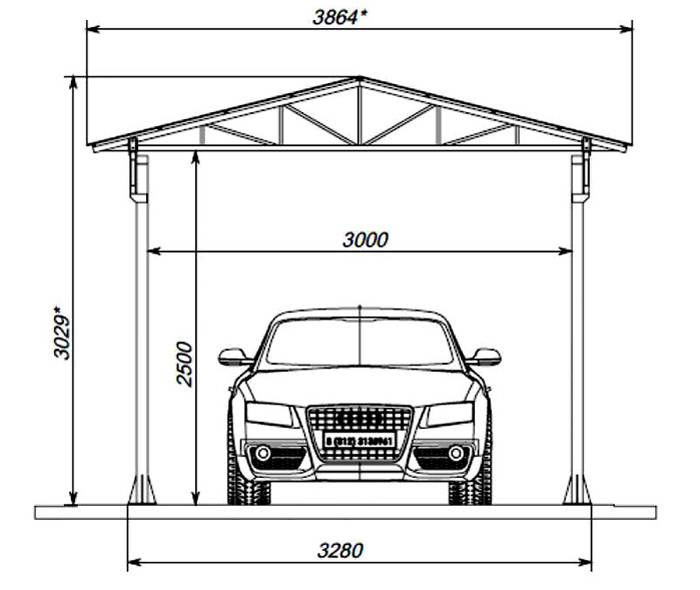
Drawing of a canopy with a gable roof

Cantilever structure diagram
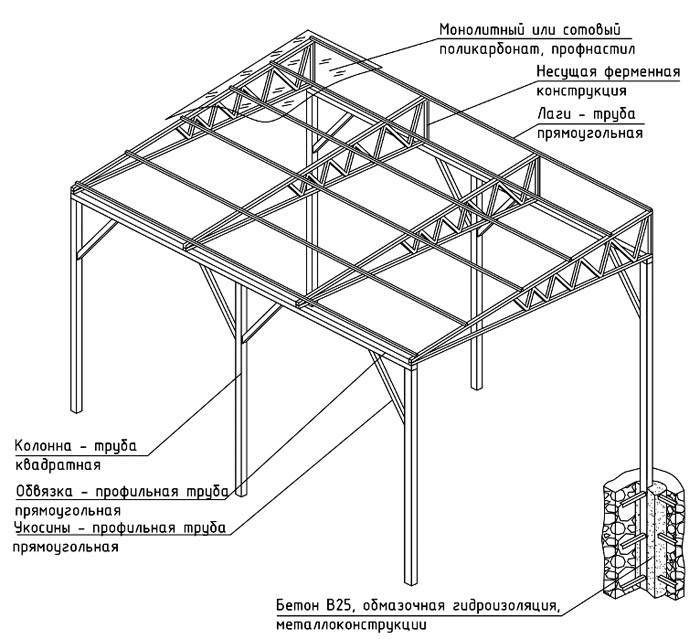
An example of a project with a pitched roof

A farm with a large span of a complex shape
Polycarbonate carports: simple and reliable
In the process of making this polymer material, dyes are added to the composition. They create not only the desired aesthetic characteristics, but also change the transparency.
| Colour | Light transmission,% |
|---|---|
| absent | 80-85 |
| yellow | 65-75 |
| Orange | 55-60 |
| brown and bronze shades | 40-45 |
| blue and green | 25-35 |
| Red | 10-15 |
Here are the average parameters of the products of one profile manufacturer. Currently, products are produced with different levels of color saturation, which allows you to obtain different levels of transparency, up to its complete absence. A wide range of offers allows you to choose an option in strict accordance with the criteria defined by the project.
Carport polycarbonate is highly UV resistant. To reduce weight, sheets with cavities (honeycomb structures) are created. It is easier to assemble such products with your own hands. They are lighter than their monolithic counterparts, but are designed for a shorter service life.
| Options | unit of measurement | Type of material | |
|---|---|---|---|
| Monolithic | Cellular | ||
| Specific gravity | kg per sq. m. | 7,1-7,5 | 1,1-1,3 |
| Life time | years | 10-15 | 20-25 |
The thickness of the polycarbonate is selected taking into account the specifics of the instructions and possible loads during use:
- For a standard one-, two-slope, arched canopy over the machine: 4-6 mm.
- Overlap of the span for two cars: 8 mm.
- Particularly large distances between reference lines, increased wind and loads in a certain region: 10 mm or more.
| Material type | Brand / Name | Thickness, mm | Sheet dimensions (width x length), cm | price, rub. |
|---|---|---|---|---|
| Cellular, transparent | Sellex / Matador | 3,3 | 210 x 600 | 1780-2300 |
| Cellular, transparent | Sellex / Solaris | 4 | 210 x 600 | 1950-2200 |
| Cellular, transparent | Sellex / Premium | 4 | 210 x 600 | 2900-3250 |
| Cellular, color | Sellex / Comfort | 4 | 210 x 600 | 2380-2800 |
| Cellular, transparent | Plastilux / ULTRAMARIN | 6 | 210 x 600 | 3020-3400 |
| Cellular, color | Plastilux / SUNNEX | 6 | 210 x 600 | 3900-4100 |
| Cellular, transparent | Sellex / Solaris | 8 | 210 x 600 | 4080-4300 |
| Cellular, color | Plastilux / SUNNEX | 10 | 210 x 600 | 4300-4500 |
| Monolithic, transparent | Polygal | 6 | 205 x 305 | 13200-14800 |
| Monolithic, colored | Polygal | 12 | 205 x 305 | 26800-28400 |
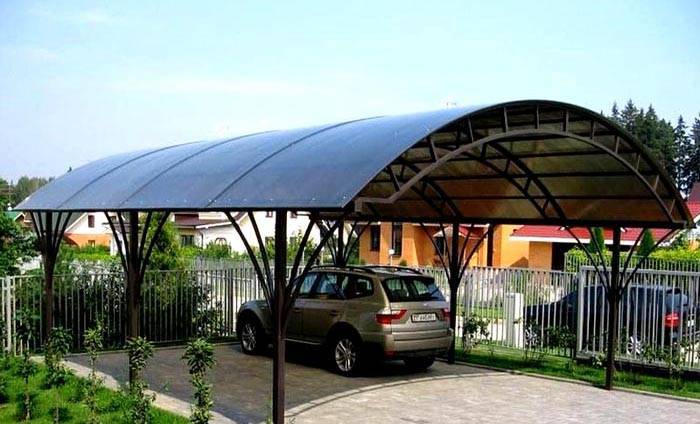
The length of the sheet reaches 12 m, which is useful for covering large spans with a width of 2 cars

As large as in the photo, a canopy made of polycarbonate sheets will not turn out too heavy
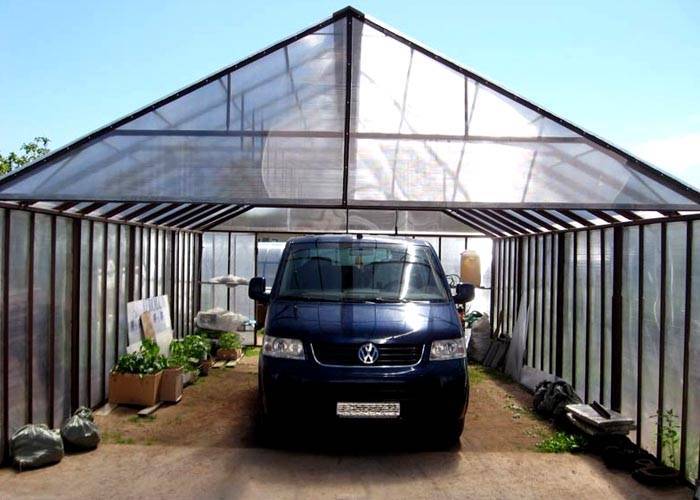
Cottage canopy with walls
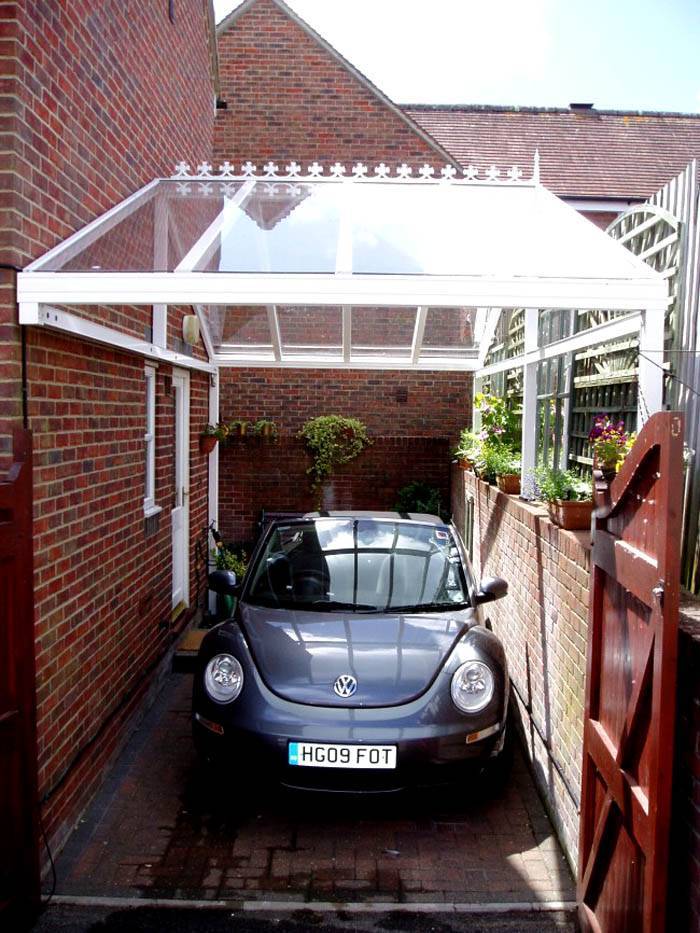
Inexpensive "replacement" garage
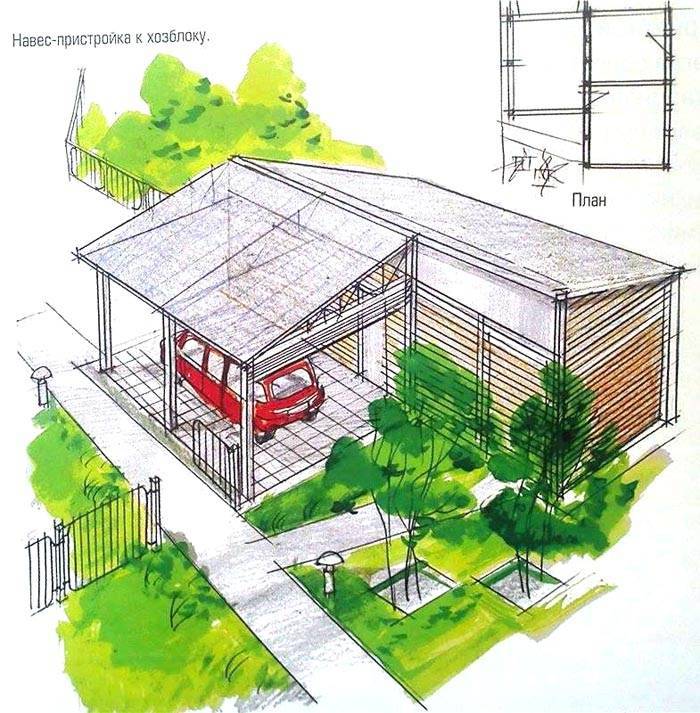
The figure shows how to make a simple extension to a utility block with a pitched roof
Carport made of corrugated board: iron to iron
This material is well suited for roofing. It weighs a little and is well protected from corrosion by a multilayer coating. Strong mechanical stress cannot damage it. Structures from a profiled sheet are not too difficult to build with your own hands.
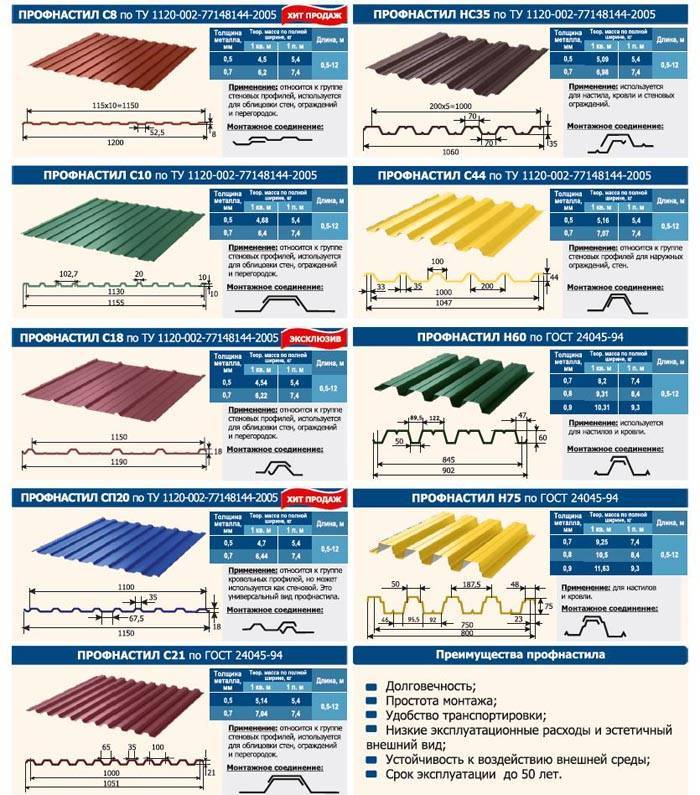
In a wide range of products in this category, you can quickly select the best coating option for color, profile, thickness and cost
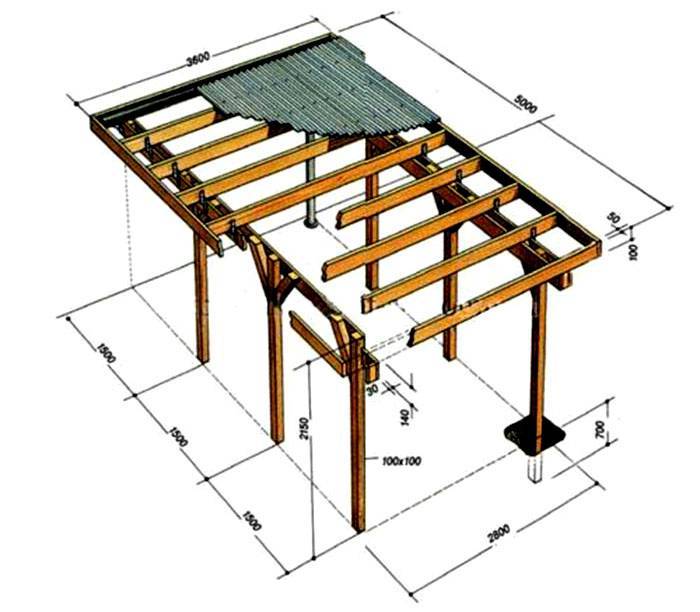
This drawing can be used to create a small carport.
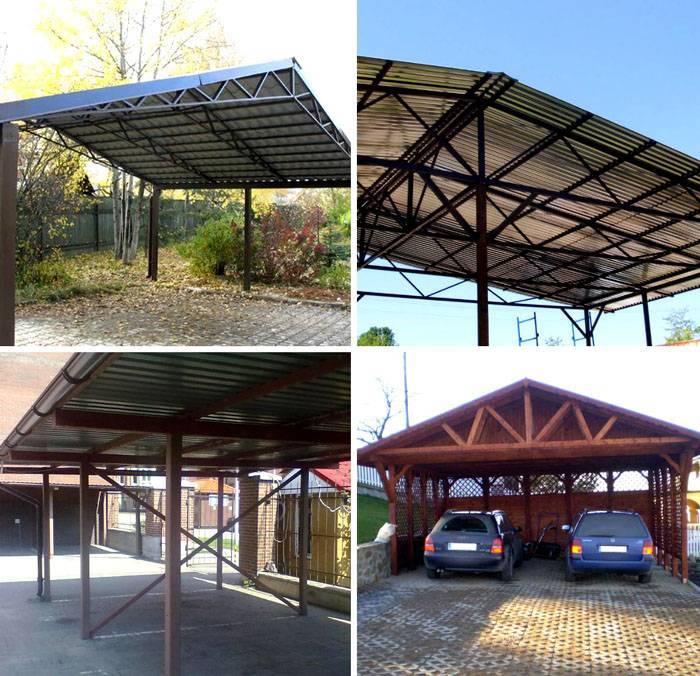
The photo shows that profiled sheets are suitable for the construction of large structures.
When choosing these products, the following factors should be considered:
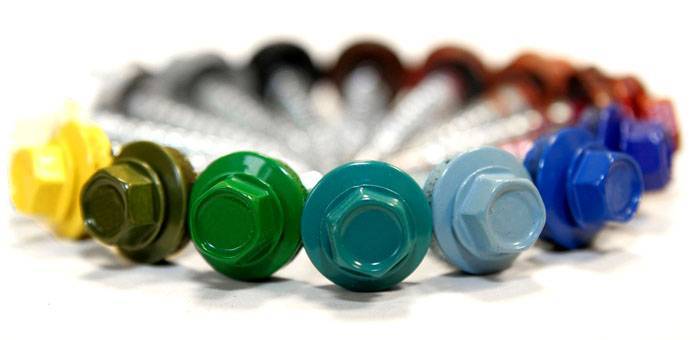
Special screws with rubber washers ensure reliable fixing of sheets, prevent moisture ingress.The color can be matched according to the decorative coating of the sheet
Carport made of metal tiles: we make one whole with the house
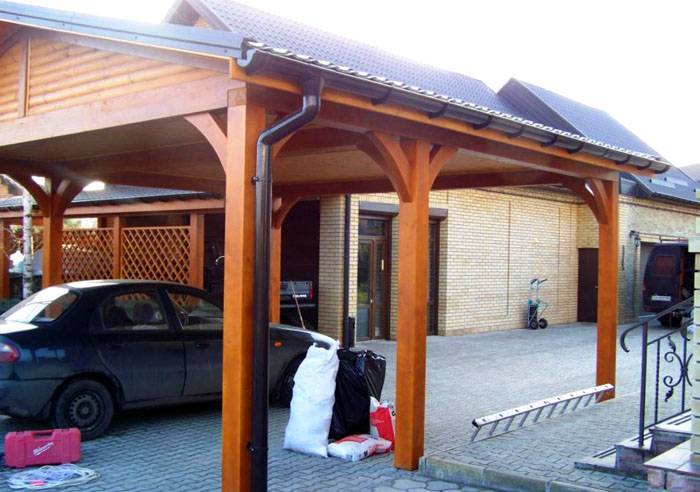
The photo shows an example with the same material on the roofs of the main building and annex. This solution simplifies the creation of a single harmonious architectural ensemble.

As in the previous versions, a drawing will come in handy.
In the process of creating it, it is necessary to coordinate the dimensions of the roof slope cells with the width and length of the metal tile sheets. It is necessary to provide reliable support at the joints. A careful study of the design makes it easier to build with your own hands. It will also be useful if the project is commissioned to be carried out on a turnkey basis by a specialized company. The knowledge gained will help control the actions of the performers.
Sheds in the yard made of fabric
If you do not want to mess around with complex structures of metal or wood canopies, we recommend that you turn your attention to lightweight awning-awnings made of dense fabric. They are sold already with a ready-made metal frame, which is attached to the wall, so there is no need to build anything extra
A special advantage of this design is the ability to quickly remove the awning, simply by folding it - special levers and automation allow you to do this in a second.
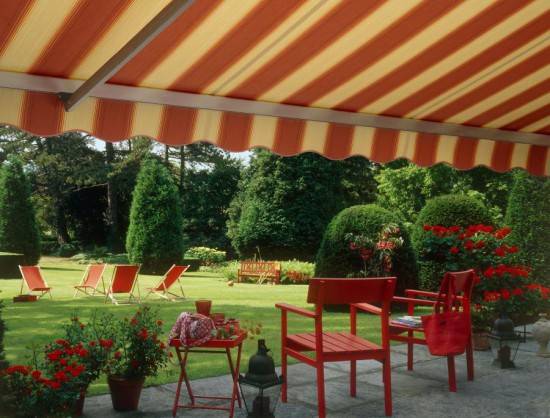
Fabric sun canopy
A fabric awning can be made independently, but then it will differ little from buildings made of profiled sheet or polycarbonate, although the appearance of such a canopy will be more picturesque and interesting. Such a canopy from the sun can be made by constructing a frame made of metal and putting on a canvas of bright fabric.

Country canopies made of fabric
Material for frame and supporting structure
The "skeleton" of a mini-garage is formed from the following materials:
- wood;
- metal;
- stone;
- brick;
- concrete.

Support pillars and roof frame parts are made according to precise geometric technology with straight, diagonal and rounded elements. In the case of wood, there are at least 4 basic options for joining roof parts. They are connected with ordinary and construction hardware. Metal structures are welded. Working with wood and metal requires the participation of at least a few people. With brick, stone and concrete buildings, the situation is more complicated. You can still build a brick structure on your own, but not concrete or stone. In the last 2 cases, teams of foremen work. Metal awnings look good against the backdrop of garden plants, just like wooden ones. They have many absolute advantages, and well-processed wooden ones have at least a beautiful look. Stone mini-garages are not much inferior to them in terms of aesthetics. In addition, stone buildings look more modern. Brick and concrete sheds are decorated with panels or something like that.
Stone, concrete or brick
For self-construction, these are not the best materials. The frame and supporting structure made of brick, concrete and stone take much longer to calculate. Heavy equipment is used to install bulky elements. The coverings of the finished canopy are left unchanged or they are finished with something like lining, siding, embossed panels. As a result, owners get an aesthetically pleasing build and save money by ditching a conventional garage. The combination of materials, including the topcoat, offers advantages in terms of durability. Maintenance of stone / brick / concrete pillars does not require much effort, but takes more time than maintenance of structures on thin pillars. The brick structure is primarily about durability and variability in terms of configuration. They try to emphasize good taste and status with a stone, and the coatings do not require additional finishing.

Metal
Profiled pipes with a section of 80 × 80 mm are also used.Modifications are selected with protection against dampness, because the metal corrodes. After the foundation is poured, points are marked for the pillars, after which indentations are made with a drill. This is a convenient approach with high precision. The holes are then poured with concrete. The pillars are connected with crossbars and go to the main frame. The metal top of the canopy is mounted with a welding machine. The roof frame is made closed or everything is left free except for the top layer with the roofing material. That is, as a result, they get a monolithic structure or a canopy with a farm. The upper part of the metal canopy is assembled from profiled pipes with a cross section of 40 × 20 mm. Long curved elements will have to be made under wide awnings, and the complexity of the work will increase several times.

Wood
Anyone who is more or less versed in carpentry and construction will be able to assemble a homemade structure from wood. Self-processing and preparation of wood leads to a significant loss of time. It includes cutting, preparation of elements. Although the preliminary work will take at least a week, it will be relatively easy to complete, especially since there is the largest selection of tools for woodworking. All nodes are connected with plates and hardware. Wood is used mainly in the form of bars. They are inserted into the foundation or screwed in with special metal joints with large anchors. The material for the canopy is processed with double care so that fungus does not appear on the tree next to vehicles and car accessories. Aesthetically speaking, the worst that can happen is cracking. Wood is inferior in durability to other materials.

Construction
Now directly about the construction of the canopy itself.
- Initially, the site is being prepared;
- After that, the supporting racks are installed. Their number is determined from the size of the building. To reduce the load on the structure, it is necessary to install it on a rack every 2 m of the canopy length. That is, a building with a length of 4 m should have 3 racks on one side, and there will be 6 of them in total;
- Before making the roof frame, its shape is determined. The roof can be straight with a slope on one or two sides, wavy, in the form of an arch, etc. It all depends on the imagination and material of the shelter.
Let's analyze the simplest design - a separate wooden canopy for one medium-sized car with a polycarbonate coating and a slope to one side. The canopy is 5 m long and 3.5 m wide.
So, first, the site is prepared - it is leveled, concreted or asphalted, but you can just fill it up with rubble.

Since the length is 5 meters, it is better to install 4 racks with a distance of 1.25 m. This will distribute the load as much as possible, but if there are 3 racks on each side, then you will have to use massive wooden columns so that they can hold the load.
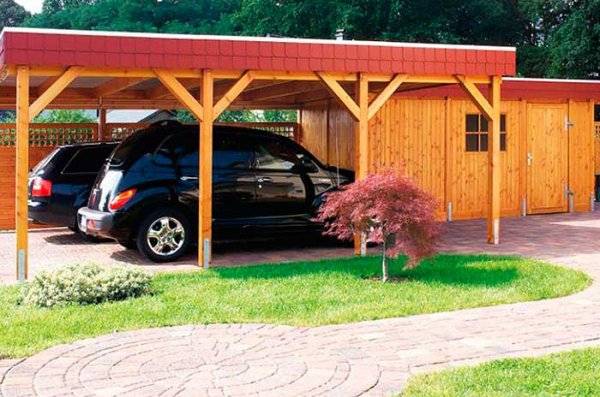
On one side, the posts should be 10-15 cm higher than on the other in order to provide a slope.
After installing the racks from above, load-bearing beams are fixed along them. Each beam must be the same length as the building. To give strength to the structure, braces are made between the uprights and beams.
Logs of boards are laid transversely on these beams and fixed. It remains to correctly lay the polycarbonate sheets on the logs and fix them with self-tapping screws.
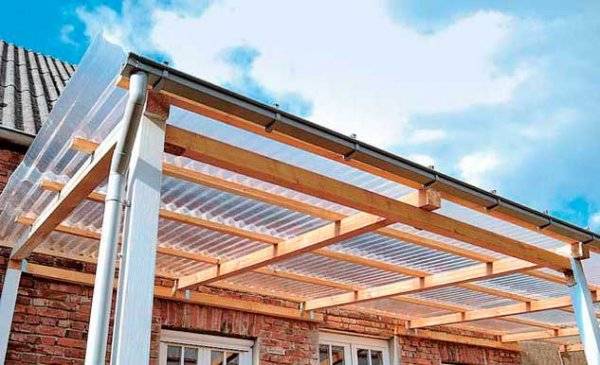
The final stage is decorative finishing, processing of wooden elements with water-repellent and protective agents. If necessary, walls are made of polycarbonate sheets, attaching them to the racks from the sides.
This is the simplest of the sheds that can be built in a summer cottage. With the right organization, such a building can be erected in just a day, with the necessary materials and tools.
From corrugated board
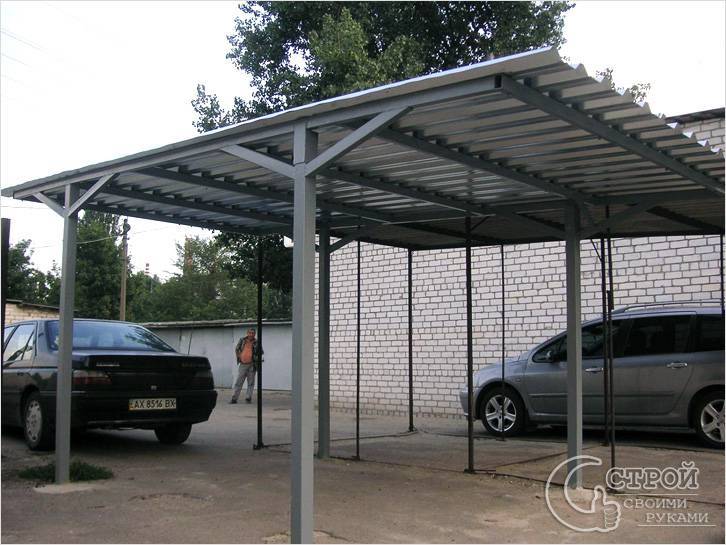 For a machine made of corrugated board
For a machine made of corrugated board
Carports made of corrugated board, most often used for parking cars in the country. Such structures stand separately and do not adjoin the wall of the house. The roof of the canopy is supported by vertically installed metal pillars. The main beams and the crate are mounted on them, and corrugated sheets are attached to it from above.
To make a free-standing canopy from a metal profile, you will need several racks made of a metal pipe. Dig holes 60 cm deep. Their number depends on the number of supports and the size of the canopy. Place the racks with a step length of 1 m.At the bottom of the pit, lay a cushion of rubble, set the rack vertically, fill the pit with concrete.
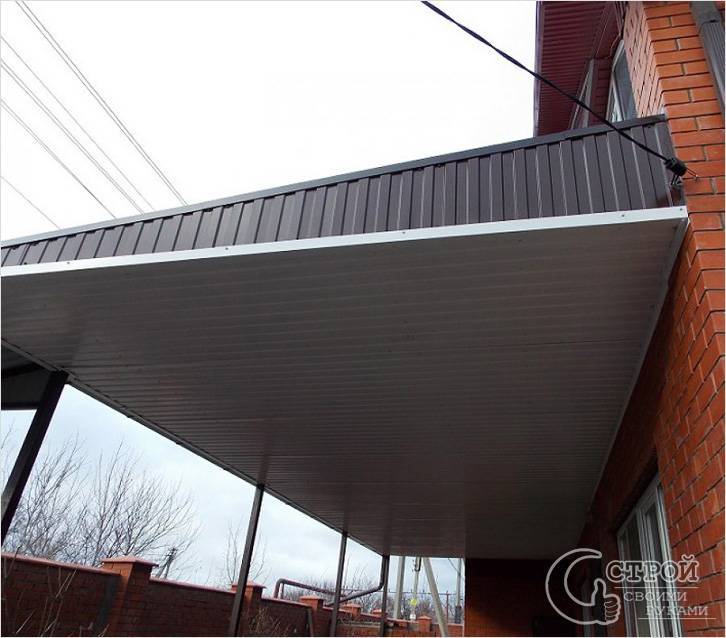 Sutured canopy made of corrugated board
Sutured canopy made of corrugated board
After waiting for the concrete to dry completely, continue installing the canopy. The next stage of the work will be the installation of horizontal beams, do this by welding. The lathing on such awnings is made of small diameter metal pipes. Use self-tapping screws to mount the sheets of roofing material on the battens.
The absence of a welding machine is often an obstacle to the construction of a canopy from a metal profile. Bolted fasteners are a lot of hassle.
Roofing selection: emphasis on style!
Now with the design, everything is more or less clear, and you can move on to the roof. Almost any roofing material is suitable for arranging a summer cottage for a car, as long as it is light enough and does not put too much pressure on the supports (like ceramic tiles, for example).
Thin metal roofing or soft bituminous shingles are ideal for this purpose.
But it is polycarbonate that perfectly fits into the surrounding landscape design, color or transparent - it doesn't matter
It is important that it gently diffuses light, and it will be comfortable to tinker with the car both in the rain and on a hot afternoon:

If you opted for just such an option, then get ready for the fact that there will be a lot of work, but the strength and durability of the entire structure is definitely worth it.
Even a small canopy right in front of the entrance to the country house looks bright, stylish and quite practical:
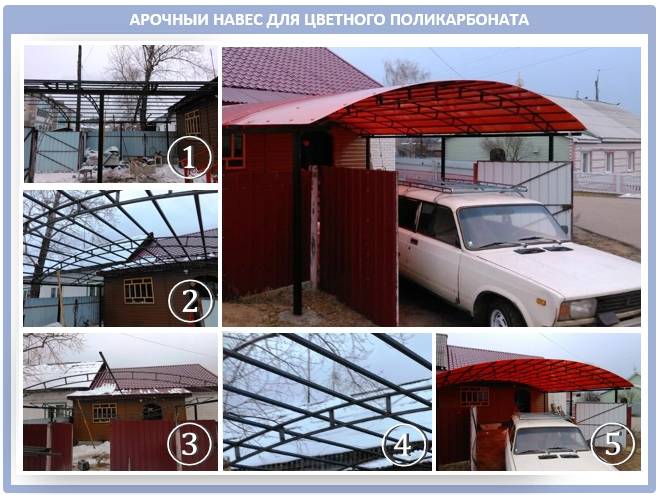
By the way, polycarbonate is such a light material that it allows you to build even such a thin frame under it:
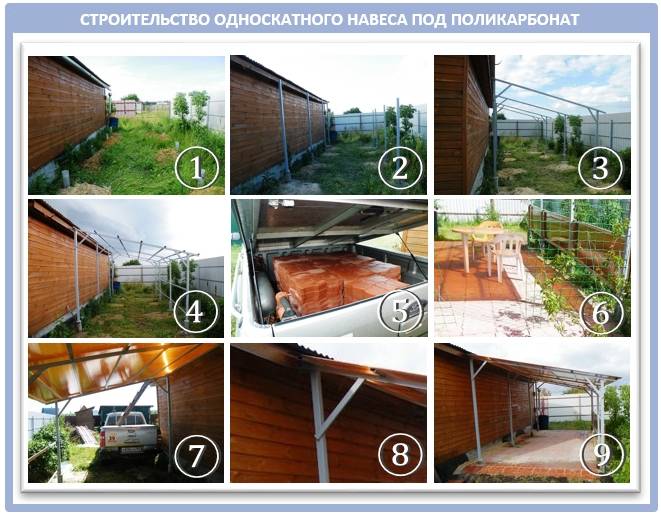
If you want something unusual, or you are not yet ready to purchase the same polycarbonate, then use the advice of skilled summer residents. Have you ever imagined that a canopy can literally be built from plastic bottles? Country crafts - yes, small attributes for the garden, yes, but - a whole building ?!
As it turned out - as much as possible, see what comes of it:
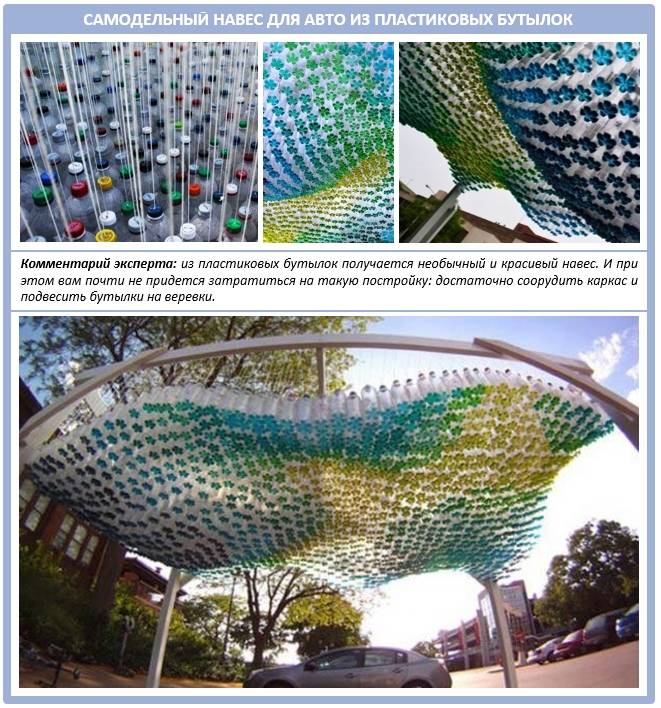
For this venture, you will only need transparent plastic bottles, water, paint of different colors (you can use ordinary gouache), wooden racks and a strong rope.
The installation instruction itself is ingeniously simple:
- Step 1. First, prepare the bottles: pour a little water on the bottom of each one, paint it in the desired color and fill it with decorative ornaments if desired.
- Step 2. Next, make holes in the caps of the plastic bottles and thread the ropes through them. Tie them on the inside, making a knot.
- Step 3. Build a flat horizontal frame from wooden planks.
- Step 4. Drive nails around the perimeter of the frame and pull the rope net.
- Step 5. Tie plastic bottles to this net so that they are squeezed tightly enough to each other.
Interestingly, this can be easily done with a ready-made pergola, and you will not need to build a separate frame. And the roof itself is short-lived, of course, because the plastic begins to deteriorate in the first 5 years in direct sunlight. But why not build a new "roof" in a couple of years? Moreover, the whole process takes at least a couple of hours.
The choice of roofing material
Instead of numerous selection criteria, one principle can be applied - use the same material as for the roof of the main house. The validity of the monolithic option grows if the canopy is an extension. For roofing material on a rafter structure, a crate is made of transverse slats or canvases. A lattice is formed under hard coatings, and a continuous version of canvases under soft ones. At the same time, manufacturers indicate exact information about the pitch for sparse crate, as well as about the configuration in general. Hard cover is definitely better. Moreover, one of the options, the corrugated board is suitable for self-assembly. If we take polycarbonate, then it is better - multi-chamber. With at least 3 rows of plastic and 2 rows of cells - to protect vehicles from heat. By the same principle, you can take roofing material in light shades.
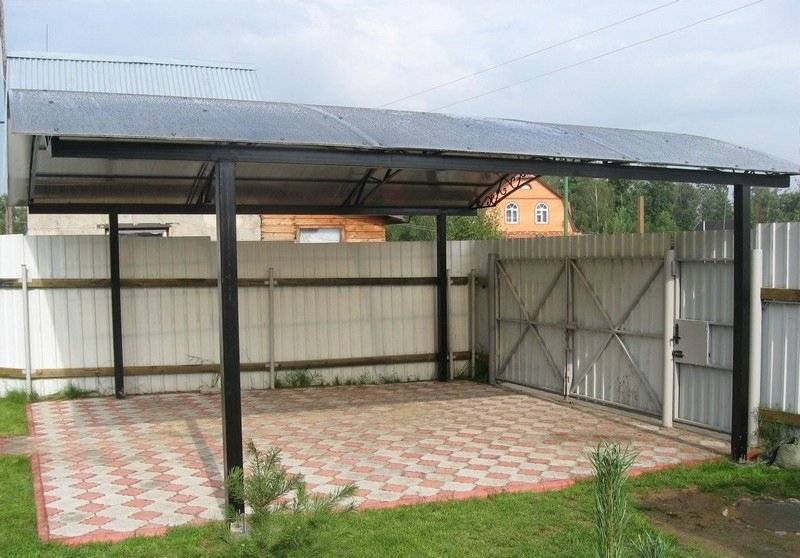
Polycarbonate
The buyer usually gets 2 options: monolithic material or honeycomb. They almost do not differ in the standard sheet width - about 2000 mm. The honeycomb has long panel models of 6 and 12 m, while the monolithic standard is 3 m. In terms of specific gravity, monolithic ones are worse, because it is almost 6 times heavier: 7.2 kg / m² at 1.3 kg / m² for segmented ones. The latter have a larger bending radius. Monolithic polycarbonate lasts up to 25 years, and less reliable cellular - only 10.

The segmented material has a higher resistance to heat transfer. But the coefficient of light transmission is approximately equal. In the cell phone, it corresponds to 82%, and in the other variety - 85%.
SNiP II-3-79 and SNiP 21-01-97 will help you to choose the ideal thickness. Protection from strong winds will be provided by models with a thickness of 6 to 8 mm. Panels thicker than 10 mm are installed due to difficult weather conditions.
Corrugated board
When choosing a corrugated board, they pay attention to 5 criteria, not counting the issue of delivery. Including the following:
- Thickness;
- Appearance;
- Wave features;
- Smooth edges;
- Price.
The first of them, the thickness is selected according to the principle "the larger the indicator, the better." If you use decking for the roof, then the second rule also works: there should not be an excessive load on the base. For the roof on the site, a thickness of 0.5 mm or more is suitable. Sheets should be checked for stains and scratches. This is the second point. In turn, the geometry of the wave determines the compatibility with the roof. Look at the dimensions and thickness of the ridge. A good corrugated board has edges that are perfectly even and do not have jags. A material that is bad according to this criterion will be covered with rust in places with imperfections. It is not worth buying a profiled sheet with a large thickness and a low price. It is probably of poor quality or even a fake. Delivery sometimes becomes a problem, because the sheets at this moment can bend and deteriorate.

Shingles
It can be hard and soft. People prefer bituminous and metal tiles.
The soft one is not put at low temperatures, because it partially hardens and becomes brittle. You cannot walk on it in the heat - in this case, it softens. On the other hand, shingles produce a minimum of waste on curved surfaces. Complex shaped elements are trimmed with soft tiles. In terms of durability, it also has an advantage, but it all depends on the operation. With a maximum of 50 years for metal tiles, bituminous tiles can last as much as 70 years.
Solid shingles are more reliable and practical. It does not deform and has a high temperature limit. But because of the sudden melting of snow, a system is sometimes put on it to stop it. These are additional costs. Among the disadvantages of metal tiles is also the problem of noise resonance.

DIY wooden carport construction
Any construction process includes several stages. During the construction of a structure for a car, you will need to do the following:
- choose a suitable place for construction;
- pour the foundation;
- installation frame;
- carry out roofing work;
Choosing a place to build
Before starting the construction of a canopy in the country, you need to decide whether it will be an independent structure or an extension to an existing one. The best place to build is the area in front of the entrance. You can also store inventory there while you work. In addition, it is advisable to build a canopy on an elevated position. Then puddles will not accumulate under it.

Foundation
The base for the structure must withstand the entire load of the frame and roof. There are two options for pouring the foundation. You can use a pile-screw structure, which will make the finished structure stable.
Erection of the frame
After the installation of vertical piles, longitudinal beams are mounted along the entire length of the structure. In this case, it is necessary to control the angle of attachment. The longitudinal beams, which are fixed on the opposite side of the roof, are installed only after checking the slope level. It is not desirable that the angle of inclination exceeds 3 degrees.
After that, you need to lay the rafters so that the roof can be installed on them. It is worth leaving a distance of at least 60 centimeters between the rafter boards. Such boards are screwed to the support beams with screws. If there is a gutter in the plan for draining water, about 10 centimeters should be cut off from the last rafter.
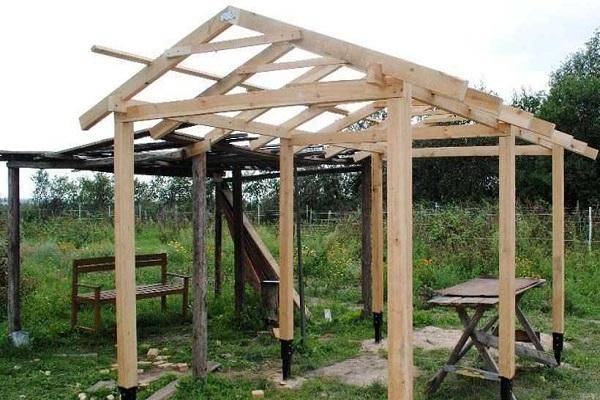
Roof installation
The final stage of construction is the laying of the roofing material. For the roof, you can use slate, shingles, wood, glass insulation or polycarbonate. However, when using boards, the roof may leak, so it will be necessary to cover it with a layer of anti-rotting material.
When using slate or polycarbonate, such problems will not arise. Sheets are fastened from the bottom to the top, so that each next sheet overlaps the joint with the previous one.
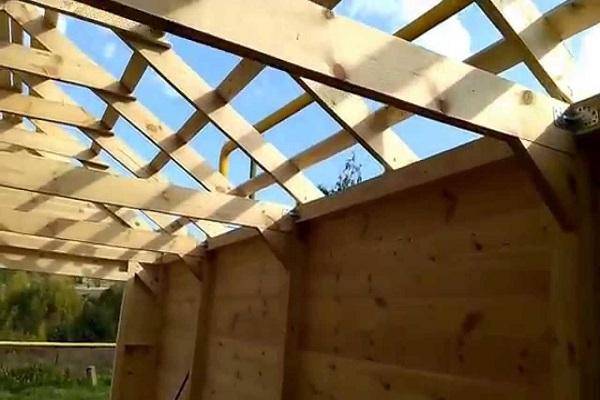
On the gable roof on top of the structure, attach a visor to prevent moisture from entering. After laying the gutter, it is worth directing the pipe vertically down. Around the foundation, at a short distance, it is worth digging small trenches that serve to drain excess water. To avoid inconvenience, you can cover them with a rigid net.
We create a project
After you have decided on the material, you need to make a sketch of the construction site. It is necessary to take into account the location, dimensions and appearance of the structure.









It is necessary to draw up a project taking into account the design features and location:
- Take measurements near the house, above the door. In these places, the canopy will be adjacent to the building.
- When making a structure for a car, it is necessary to take into account the location of the supports so that the entry / exit is consolidated.
- The design for the recreation area should take into account the height of the barbecue, barbecue, that is, adhere to fire safety rules.
- Above the pool, materials are used that can withstand high humidity, taking into account the size of the reservoir.

The roof can also be of different configurations: straight, with a slope, one- or two-slope, complex.

For the stability of the device and the retention of forms without deformation, it is necessary to make a calculation in which to take into account the speed, direction of the wind, the amount of snow.


Choosing a location
The protective function of the canopy is very important, but its location and compatibility with the design of the structure are also important. If a summer cottage, a country house, also located within the city, has not yet been built, in this case, the canopy is installed separately from the structure being built
It is good to attach the structure to the facade of the house, directly against its wall.
If the size of the site allows, then preference is given to a canopy with a larger area, under which several cars can be placed. This will perfectly solve the problem with relatives who came to visit by car, the presence of several cars in the family.When choosing the side of the facade, the windy side, the architectural differences of the house are taken into account, sometimes its design does not allow installing the structure from the front side.

